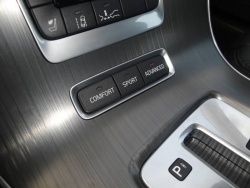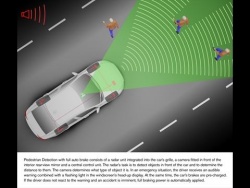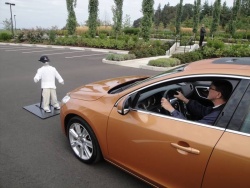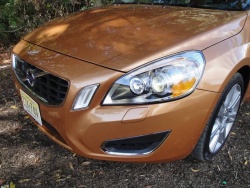Optional is Volvo’s “FOUR-C active chassis”, which has been improved for 2011. This automatically-adjusting suspension system uses sensors to continuously monitor the car’s movements, and adjust the shock absorbers to compensate for different road surfaces and body angle. The driver can choose between three suspension settings: Comfort (for a better ride), Sport (similar to the car’s standard Dynamic suspension) or Advanced (for performance driving).
   2011 Volvo S60. Click image to enlarge |
Vehicle control is further enhanced by standard Dynamic Stability and Traction Control with a new feature that uses a roll angle sensor to detect and react to understeer and oversteer. To enhance steering feel and response, the steering gear ratio was made 10 per cent faster than in previous S60s.
City Safety, an automatic braking system designed to prevent rear-end collisions, is standard in the S60. Using a closing velocity sensor, it detects when a rear-end collision is imminent, and at speeds up to 30 km/h, automatically brakes the car to avoid a rear-ender or lessen its impact.
The most interesting feature in the new S60 is its “Pedestrian Detection with Full Auto Brake”, the world’s first pedestrian avoidance system. A camera in the top of the windshield and a radar sensor in the grille combine to track the movement of pedestrians crossing in front of the car. Should the car be about to hit a pedestrian and the driver doesn’t take any evasive action, the system will sound an audible warning, then automatically brake the car to a stop if the driver doesn’t do anything. At speeds up to 35 km/h, the car will stop before hitting the pedestrian; at higher speeds, the system will reduce the force of the impact. At present, the system is only designed to recognize humans, not animals or other objects crossing in front of the car.
In a demonstration using a dummy dressed as a child pedestrian, journalists drove directly towards the dummy at 35 km/h without succumbing to the natural urge to brake or steer around it. The system works as advertised with a sudden and immediate stop in front of the dummy. However, Volvo engineers stressed that it may not work at night, in poor weather, or if the pedestrian is wearing dark clothing and can’t be seen. As well, the radar device in the grille needs to be free of snow or ice in the winter time. The camera behind the windshield is behind the wiper sweep.
Volvo cited statistics that show that 11 per cent of all U.S. traffic fatalities are pedestrians. In Europe, it is 14 per cent and in China the proportion rises to 26 per cent.
 2011 Volvo S60. Click image to enlarge |
“Pedestrian Detection with Full Auto Brake takes Volvo Cars’ traditional care for the human being to a whole new dimension,” said Thomas Ahlborg, Project Director for the S60. “In recent years, we have introduced a number of solutions that help the driver avoid accidents with other vehicles. Now we are taking a giant step forward with technology that helps to increase safety for unprotected road users as well. As far as we know, we are the first car maker in the world to offer such a complete system.”
The Volvo S60 can also be equipped with Lane Departure Warning that alerts the driver if the car runs across the lane markers without the turn signal being used; Driver Alert Control (DAC) that warns tired or distracted drivers if the car is wandering; Blind Spot Information System (BLIS) that detects vehicles in the rear blind spots on both sides of the car; and dual xenon with Active Bending Lights (ABL) which swivel to follow the curve of the road.











